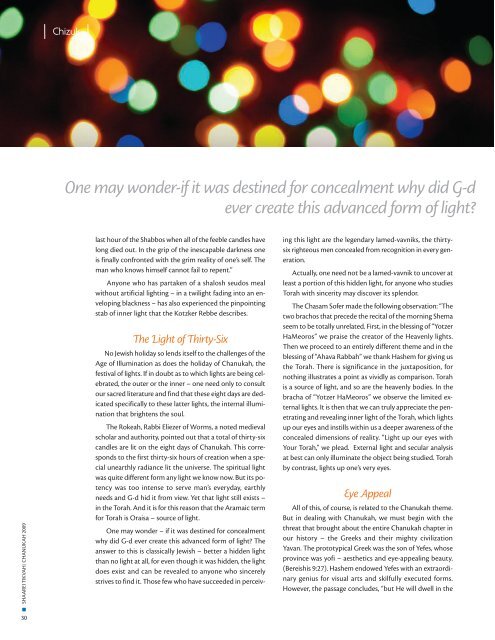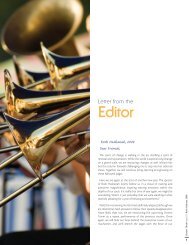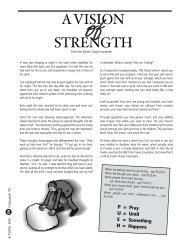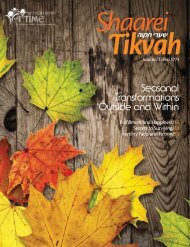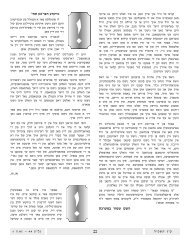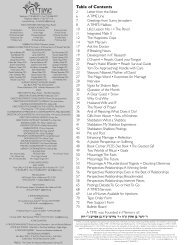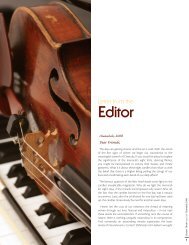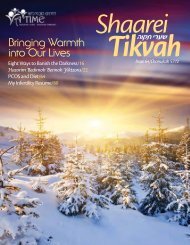Create successful ePaper yourself
Turn your PDF publications into a flip-book with our unique Google optimized e-Paper software.
Chizuk<br />
One may wonder-if it was destined for concealment why did G-d<br />
ever create this advanced form of light?<br />
SHAAREI TIKVAH/ CHANUKAH <strong>2009</strong><br />
last hour of the Shabbos when all of the feeble candles have<br />
long died out. In the grip of the inescapable darkness one<br />
is finally confronted with the grim reality of one’s self. The<br />
man who knows himself cannot fail to repent.”<br />
Anyone who has partaken of a shalosh seudos meal<br />
without artificial lighting – in a twilight fading into an enveloping<br />
blackness – has also experienced the pinpointing<br />
stab of inner light that the Kotzker Rebbe describes.<br />
The Light of Thirty-Six<br />
No <strong>Jewish</strong> holiday so lends itself to the challenges of the<br />
Age of Illumination as does the holiday of <strong>Chanukah</strong>, the<br />
festival of lights. If in doubt as to which lights are being celebrated,<br />
the outer or the inner – one need only to consult<br />
our sacred literature and find that these eight days are dedicated<br />
specifically to these latter lights, the internal illumination<br />
that brightens the soul.<br />
The Rokeah, Rabbi Eliezer of Worms, a noted medieval<br />
scholar and authority, pointed out that a total of thirty-six<br />
candles are lit on the eight days of <strong>Chanukah</strong>. This corresponds<br />
to the first thirty-six hours of creation when a special<br />
unearthly radiance lit the universe. The spiritual light<br />
was quite different form any light we know now. But its potency<br />
was too intense to serve man’s everyday, earthly<br />
needs and G-d hid it from view. Yet that light still exists –<br />
in the Torah. And it is for this reason that the Aramaic term<br />
for Torah is Oraisa – source of light.<br />
One may wonder – if it was destined for concealment<br />
why did G-d ever create this advanced form of light? The<br />
answer to this is classically <strong>Jewish</strong> – better a hidden light<br />
than no light at all, for even though it was hidden, the light<br />
does exist and can be revealed to anyone who sincerely<br />
strives to find it. Those few who have succeeded in perceiving<br />
this light are the legendary lamed-vavniks, the thirtysix<br />
righteous men concealed from recognition in every generation.<br />
Actually, one need not be a lamed-vavnik to uncover at<br />
least a portion of this hidden light, for anyone who studies<br />
Torah with sincerity may discover its splendor.<br />
The Chasam Sofer made the following observation: “The<br />
two brachos that precede the recital of the morning Shema<br />
seem to be totally unrelated. First, in the blessing of “Yotzer<br />
HaMeoros” we praise the creator of the Heavenly lights.<br />
Then we proceed to an entirely different theme and in the<br />
blessing of “Ahava Rabbah” we thank Hashem for giving us<br />
the Torah. There is significance in the juxtaposition, for<br />
nothing illustrates a point as vividly as comparison. Torah<br />
is a source of light, and so are the heavenly bodies. In the<br />
bracha of “Yotzer HaMeoros” we observe the limited external<br />
lights. It is then that we can truly appreciate the penetrating<br />
and revealing inner light of the Torah, which lights<br />
up our eyes and instills within us a deeper awareness of the<br />
concealed dimensions of reality. “Light up our eyes with<br />
Your Torah,” we plead. External light and secular analysis<br />
at best can only illuminate the object being studied. Torah<br />
by contrast, lights up one’s very eyes.<br />
Eye Appeal<br />
All of this, of course, is related to the <strong>Chanukah</strong> theme.<br />
But in dealing with <strong>Chanukah</strong>, we must begin with the<br />
threat that brought about the entire <strong>Chanukah</strong> chapter in<br />
our history – the Greeks and their mighty civilization<br />
Yavan. The prototypical Greek was the son of Yefes, whose<br />
province was yofi – aesthetics and eye-appealing beauty.<br />
(Bereishis 9:27). Hashem endowed Yefes with an extraordinary<br />
genius for visual arts and skilfully executed forms.<br />
However, the passage concludes, “but He will dwell in the<br />
30


